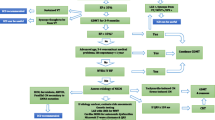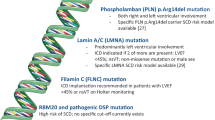Abstract
Background
Recent research has found that single nucleotide polymorphisms (SNPs) in the nitric oxide synthase 1 adaptor protein (NOS1AP) gene are associated with altered QT intervals and sudden cardiac death (SCD). However, the clinical utility and implications of NOS1AP SNPs remain unclear. Thus, this study aimed to explore the influence of NOS1AP SNPs in patients with implantable cardioverter defibrillator (ICD) for secondary prevention.
Methods
We conducted a case–control study to evaluate the most studied SNPs in NOS1AP (rs12143842, rs10494366, rs12567209, and rs16847548) in patients with ICD for secondary prevention. Patients were followed for up to 36 months from the time of ICD implantation. ICD interrogation data at 3 and 12 months, including rapid ventricular arrhythmia episodes and appropriate therapies, were then analyzed.
Results
A significant association was observed between rs10494366 and ICD recipients who experienced appropriate therapies. After a mean follow-up time of 31.70 ± 9.15 months, we detected significant differences among the three rs10494366 genotype groups in the distribution of ICD shocks and appropriate therapies, as well as in the correlation of rs10494366 and ICD shocks. According to Kaplan–Meier and Cox regression analyses, patients with the TT genotype had a higher risk of SCD than those with the GG genotype.
Conclusions
The present study revealed that NOS1AP SNP rs10494366 was associated with appropriate therapies. Specifically, the TT genotype increased ICD shocks and SCD risk in patients with ICD for secondary prevention for the first time.


Similar content being viewed by others
References
Arking DE, Pfeufer A, Post W, et al. A common genetic variant in the NOS1 regulator NOS1AP modulates cardiac repolarization. Nat Genet. 2006;38:644–51.
Kao WH, Arking DE, Post W, et al. Genetic variations in nitric oxide synthase 1 adaptor protein are associated with sudden cardiac death in US white community-based populations. Circulation. 2009;119:940–51.
Earle N, Yeo HD, Pilbrow A, et al. Single nucleotide polymorphisms in arrhythmia genes modify the risk of cardiac events and sudden death in long QT syndrome. Heart Rhythm. 2014;11:76–82.
Kolder IC, Tanck MW, Bezzina CR. Common genetic variation modulating cardiac ECG parameters and susceptibility to sudden cardiac death. J Mol Cell Cardiol. 2012;52(3):620–9.
Epstein AE, DiMarco JP, Ellenbogen KA, et al. ACC/AHA/HRS 2008 Guidelines for Device-Based Therapy of Cardiac Rhythm Abnormalities: a report of the American College of Cardiology/American Heart Association Task Force on Practice Guidelines (Writing Committee to Revise the ACC/AHA/NASPE 2002 Guideline Update for Implantation of Cardiac Pacemakers and Antiarrhythmia Devices): developed in collaboration with the American Association for Thoracic Surgery and Society of Thoracic Surgeons. Circulation. 2008;117:e350-408.
Cleland JG, Daubert JC, Erdmann E, et al. The effect of cardiac resynchronization on morbidity and mortality in heart failure. N Engl J Med. 2005;352:1539–49.
Elliott P, Andersson B, Arbustini E, et al. Classification of the cardiomyopathies: a position statement from the European Society Of Cardiology Working Group on Myocardial and Pericardial Diseases. Eur Heart J. 2008;29:270–6.
Priori SG, Aliot E, Blomstrom-Lundqvist C, et al. Task Force on Sudden Cardiac Death of the European Society of Cardiology. Eur Heart J. 2001;22:1374–450.
Miller JD, Yousuf O, Berger RD. The implantable cardioverter-defibrillator: An update. Trends Cardiovasc Med. 2015;25:606–11.
Jalife J. Ventricular fibrillation: mechanisms of initiation and maintenance. Annu Rev Physiol. 2000;62:25–50.
Mitchell LB, Pineda EA, Titus JL, Bartosch PM, Benditt DG. Sudden death in patients with implantable cardioverter defibrillators: the importance of post-shock electromechanical dissociation. J Am Coll Cardiol. 2002;39:1323–8.
The Antiarrhythmics Versus Implantable Defibrillators (AVID) Investigators. A comparison of antiarrhythmic-drug therapy with implantable defibrillators in patients resuscitated from near-fatal ventricular arrhythmias. N Engl J Med 1997;337:1576–83.
Sinha SK, Crain B, Flickinger K, et al. Clinical Inferences of Cardiovascular Implantable Electronic Device Analysis at Autopsy. J Am Coll Cardiol. 2016;68:1255–64.
Chan PS, Hayward RA. Mortality reduction by implantable cardioverter-defibrillators in high-risk patients with heart failure, ischemic heart disease, and new-onset ventricular arrhythmia: an effectiveness study. J Am Coll Cardiol. 2005;45:1474–81.
Tomas M, Napolitano C, De Giuli L, et al. Polymorphisms in the NOS1AP gene modulate QT interval duration and risk of arrhythmias in the long QT syndrome. J Am Coll Cardiol. 2010;55:2745–52.
Tobin MD, Kahonen M, Braund P, et al. Gender and effects of a common genetic variant in the NOS1 regulator NOS1AP on cardiac repolarization in 3761 individuals from two independent populations. Int J Epidemiol. 2008;37:1132–41.
Lehtinen AB, Newton-Cheh C, Ziegler JT, et al. Association of NOS1AP genetic variants with QT interval duration in families from the Diabetes Heart Study. Diabetes. 2008;57:1108–14.
Raitakari OT, Blom-Nyholm J, Koskinen TA, et al. Common variation in NOS1AP and KCNH2 genes and QT interval duration in young adults. The Cardiovascular Risk in Young Finns Study. Ann Med 2009;41:144–51.
Pfeufer A, Sanna S, Arking DE, et al. Common variants at ten loci modulate the QT interval duration in the QTSCD Study. Nat Genet. 2009;41:407–14.
Arking DE, Khera A, Xing C, et al. Multiple independent genetic factors at NOS1AP modulate the QT interval in a multi-ethnic population. PLoS One 2009;4:e4333.
Eijgelsheim M, Aarnoudse AL, Rivadeneira F, et al. Identification of a common variant at the NOS1AP locus strongly associated to QT-interval duration. Hum Mol Genet. 2009;18:347–57.
Lu J, Hu C, Hu W, et al. A common variant of NOS1AP is associated with QT interval duration in a Chinese population with Type 2 diabetes. Diabet Med. 2010;27:1074–9.
Smith JG, Avery CL, Evans DS, et al. Impact of ancestry and common genetic variants on QT interval in African Americans. Circ Cardiovasc Genet. 2012;5:647–55.
Zang X, Li S, Zhao Y, et al. Systematic Meta-Analysis of the Association Between a Common NOS1AP Genetic Polymorphism, the QTc Interval, and Sudden Death. Int Heart J. 2019;60(5):1083–90.
Wratten NS, Memoli H, Huang Y, et al. Identification of a schizophrenia-associated functional noncoding variant in NOS1AP. Am J Psychiatry. 2009;166:434–41.
Chang KC, Barth AS, Sasano T, et al. CAPON modulates cardiac repolarization via neuronal nitric oxide synthase signaling in the heart. Proc Natl Acad Sci USA. 2008;105:4477–82.
An Y, Ando K, Soga Y, et al. Mortality and predictors of appropriate implantable cardioverter defibrillator therapy in Japanese patients with Multicenter Automatic Defibrillator Implantation Trial II criteria. J Arrhythm. 2017;33:17–22.
Funding
This work was supported by Henan Province Medical Science and Technology Tackling Project (NO. 201303134); Natural Science Foundation of China (NO. U1504802); The Base and Cutting-edge Technology Research Project of Henan Province (NO. 122300410136); Joint Construction Project of Henan Medical Science and Technology Research Plan (No. LHGJ20200080).
Author information
Authors and Affiliations
Corresponding authors
Ethics declarations
Conflict of interest
The authors declare that they have no conflict of interest.
Additional information
Publisher's Note
Springer Nature remains neutral with regard to jurisdictional claims in published maps and institutional affiliations.
Supplementary information
Below is the link to the electronic supplementary material.
Rights and permissions
About this article
Cite this article
Zang, X., Zhang, S., Li, S. et al. Evaluating Common NOS1AP Variants in Patients with Implantable Cardioverter Defibrillators for Secondary Prevention. J Interv Card Electrophysiol 64, 793–800 (2022). https://doi.org/10.1007/s10840-022-01137-9
Received:
Accepted:
Published:
Issue Date:
DOI: https://doi.org/10.1007/s10840-022-01137-9




